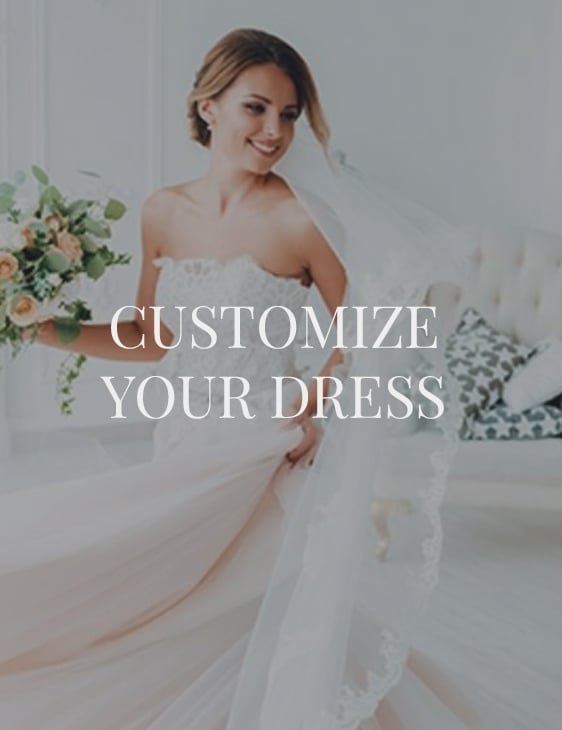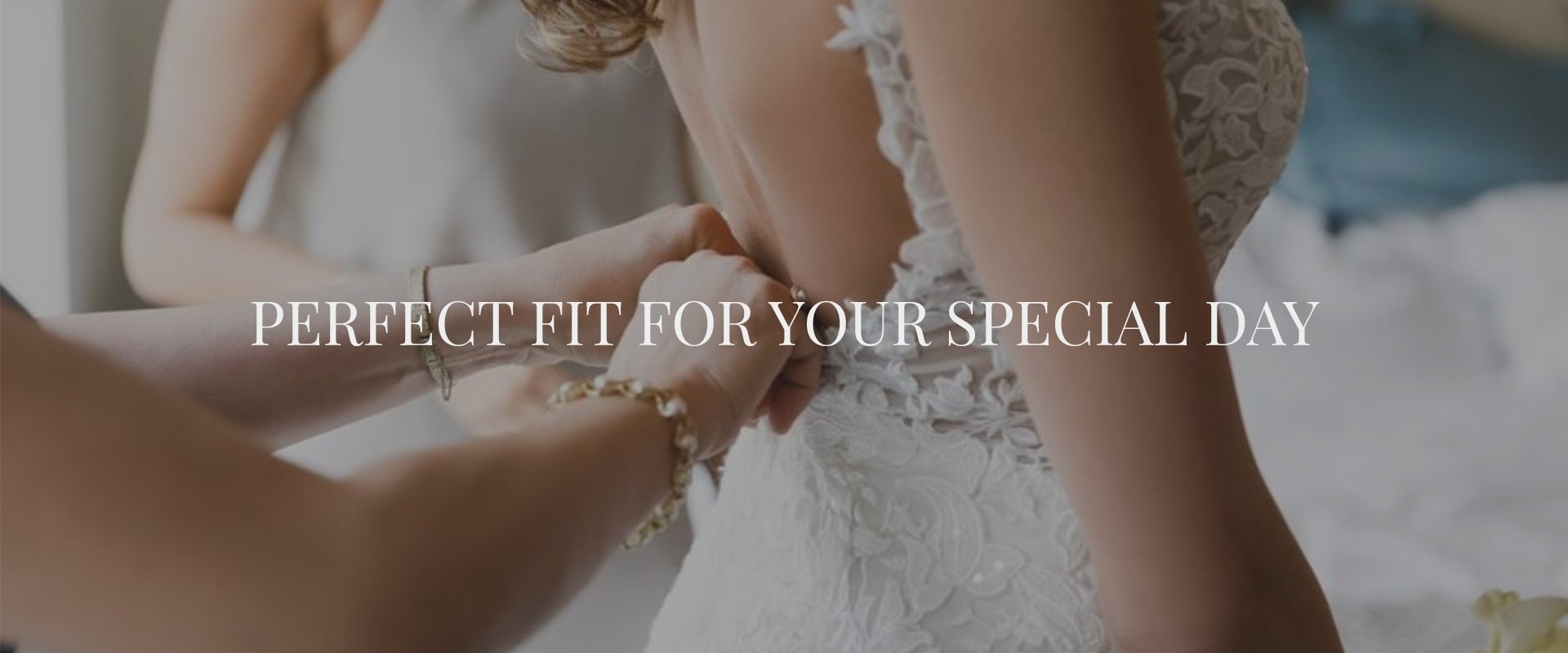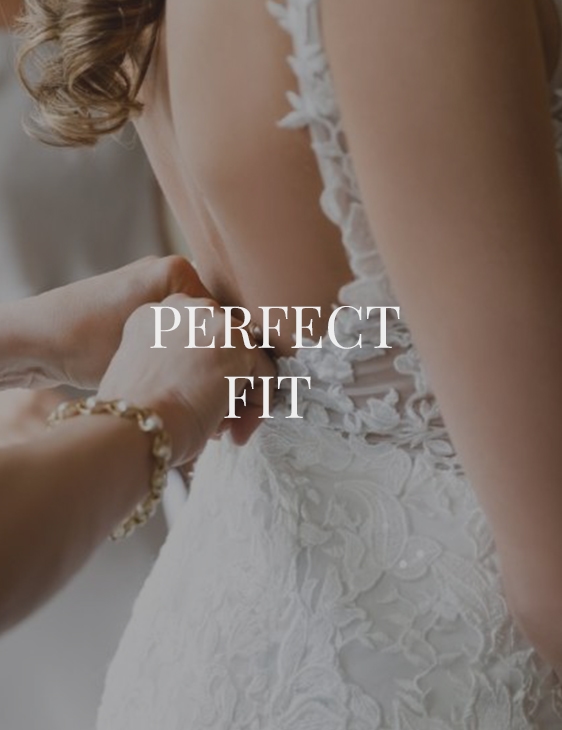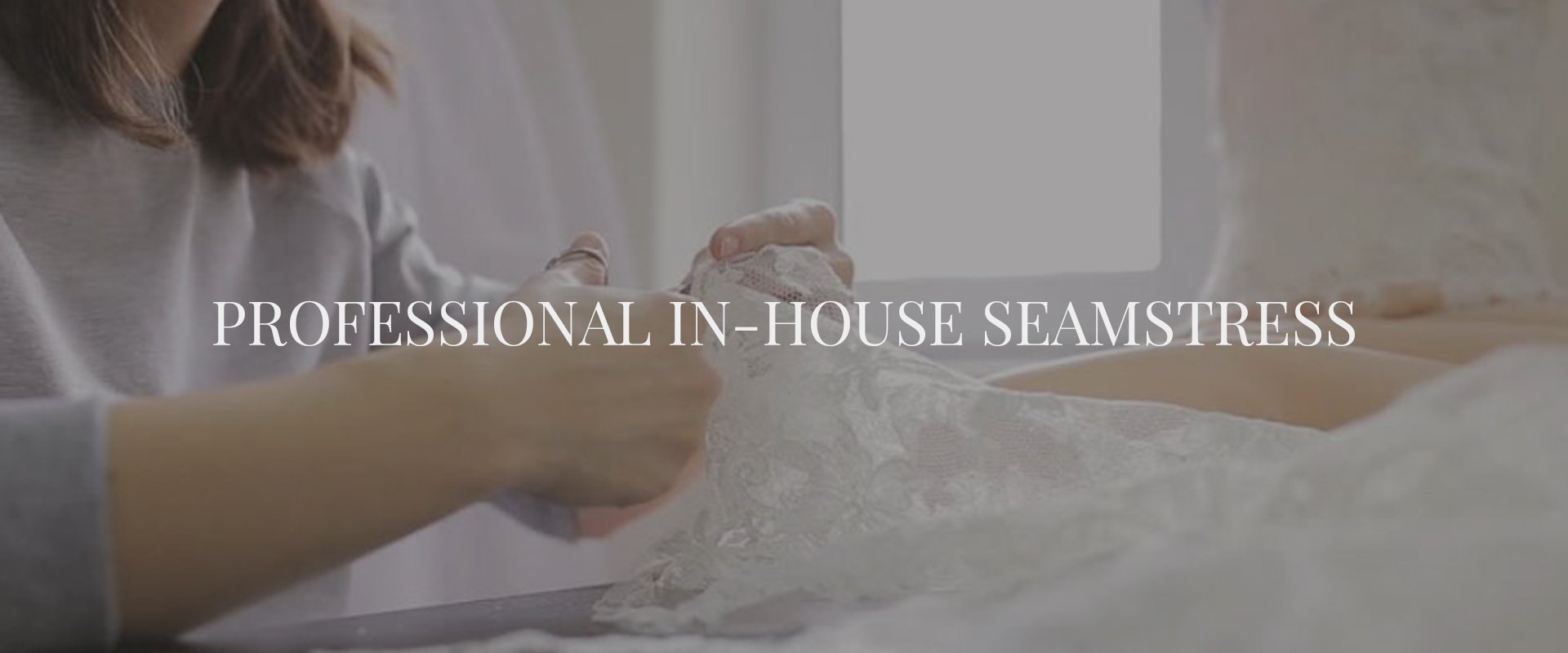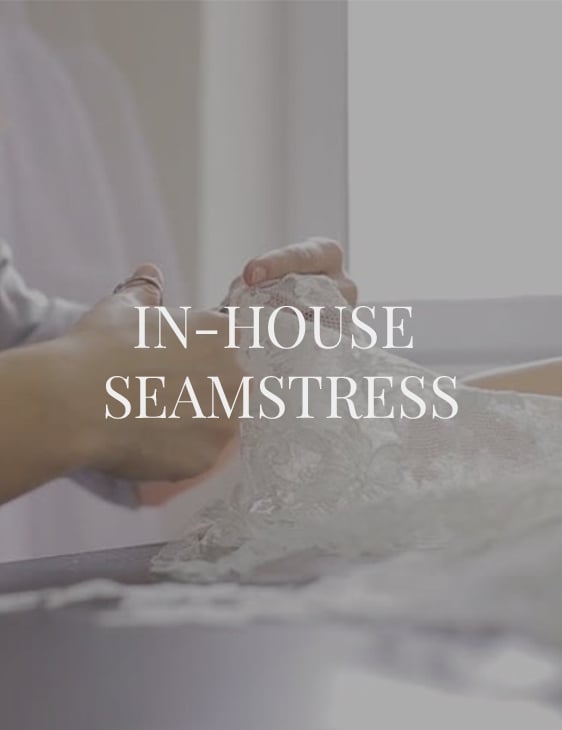Join Countless Brides Who've Trusted Our Alterations for Wedding Dresses & Bridal Gowns!
Whether It's a Wedding Dress, Bridesmaid, or Mother's Gown, We've Got You Covered!
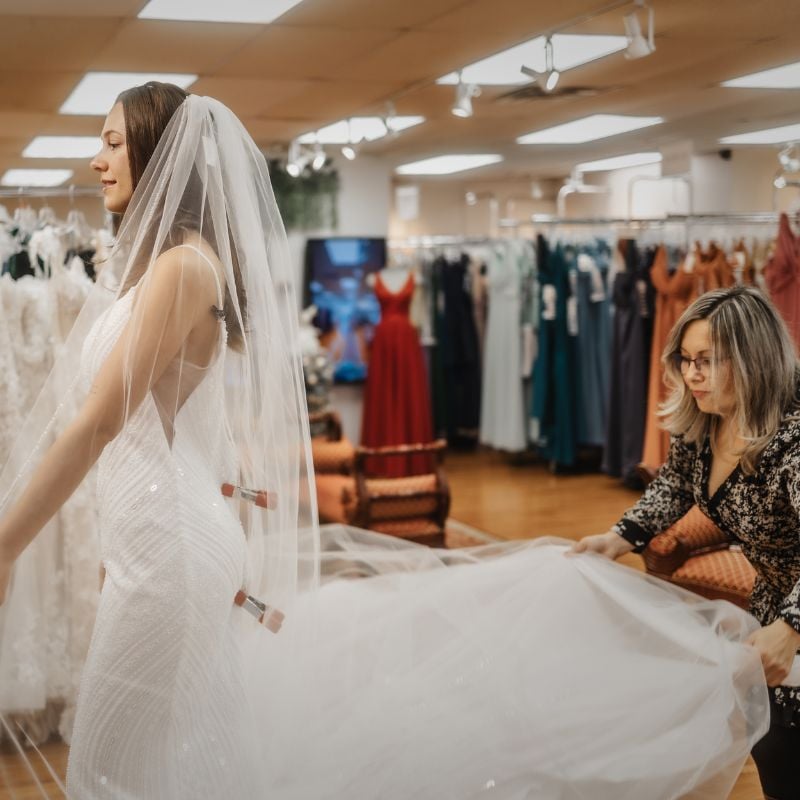
Seamless Fit: Dress Alterations
Expert. Elegant. Precise.
Discover expert in-house seamstress services at Best for Bride for your wedding and formal dresses. We specialize in precise sizing and elegant alterations to ensure your gown fits perfectly. From adjusting the bust, waist, and hem to adding bustles for comfort, our skilled team handles every detail with care. Remember to schedule early for these personalized fittings.Frequently Asked Questions
What about Bridal Gown Sizing?
A commonly asked question is about bridal sizing. Wedding gowns size usually smaller than size of the normal street clothing size. For example, if you are a 8 in regular dresses you are most likely to be a size 10 in a wedding gown. So ussualy in order to find your bridal size you need to add one size to your normal street clothing size.* Remember that the dress sometimes takes a few months to be made, so make sure you leave enough time for alterations.
How many sizes can a gown be altered?
Generally, gowns can be sized down a few sizes by a qualified wedding dress seamstress.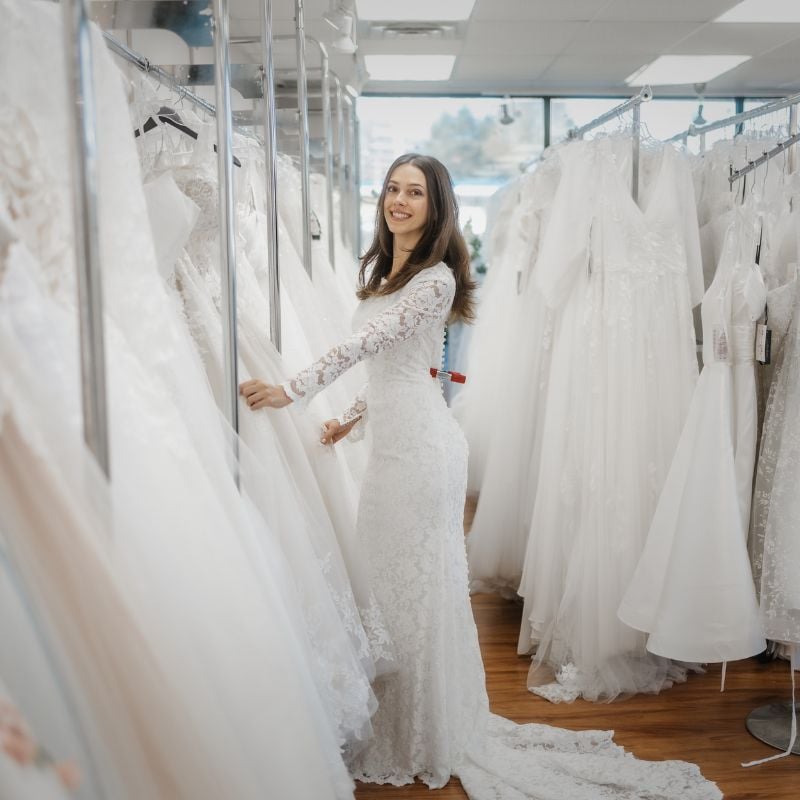
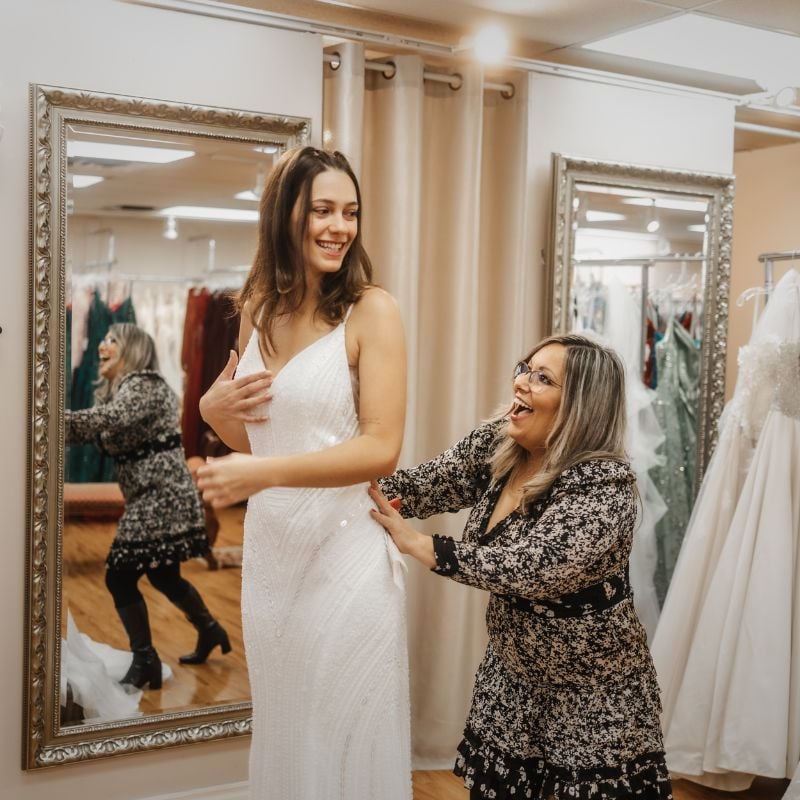
What is a "hollow-to-hem" measurement?
It is a measurement from the hollow of your neck to the floor.What alterations are normally done to a dress to make it fit?
- Bust and Waist alterations - Taking in/out sideseams or backseam in order to make a wedding dress fit a bride. Wedding gowns are usually made to allow the sideseams to be taken out up to 3 inches or 2 sizes (For example: size 10 to size 14).
- Shoulders - usually shoulder seam can be taken in to bring up a gown.
- Hem - according to the height of the bride and the shoes she is planning to wear the length of a dress can be shortened.
- Bustle - many wedding dresses have not detachable long trains. In order for the bride to move freely at the reception our seamstress can add a bustle when doing the alterations. Which means attaching the train to the back of the dress.
Many brides find us when they search for wedding dress alterations Toronto or a bridal seamstress near me, because our Toronto, Mississauga, Hamilton and Barrie locations offer in-house experts for bridal gowns, bridesmaid dresses, evening and prom gowns so everything fits perfectly for your big day.
A Guide to Wedding Dress Alterations
Introduction
Every bride wants a perfect wedding-the perfect venue, menu, décor and most of all, the perfect wedding dress. Having the right wedding dress is not just about finding the dress of your dreams, it is also about having it fit you perfectly. Only then will the dress be right in every way.
Even the most expensive wedding gown will not look great unless the fit is correct. Unless you have your wedding dress custom-created for your specific measurements, you will most likely need few fittings and tailoring. This is because wedding dress designers follow standard measurement charts for sizing dresses. To fit a dress size correctly, your bust, waist and hip measurements should closely match the sizing system followed. This is not always the case, as it is possible that your bust measurements fit one size, while your hips fit another. The result is an ill-fitting gown. Fortunately, almost everything about a wedding dress can be fixed, and with the right type of alterations you can look fabulous on your wedding day. So, let us try to understand all about wedding dress alterations, beginning with who needs them. Who needs bridal gown alterations?
In general, there are two main categories of brides who need dress alterations.
Almost 90% of brides who buy a brand new wedding dress need alterations. Like we mentioned before, dresses are created according to sizing charts, and it is highly unlikely that all your measurements will match the designer's chart exactly. This is why every bride with a wedding dress that wasn't created specifically for her, usually needs at least minor alterations. Basic alterations include taking in and letting out of a gown by altering the bust, waist and shoulder measurements, hemline adjustment and fixing the bustle. Apart from this, wedding dress alteration services can add or take away embellishments like lace and beading from a gown. They can also add or remove sleeves, change necklines and hemlines, and take away or add layers to the skirt of a wedding dress.
Alteration services also allow you to add changes to an existing wedding gown, so you have one that is closer to your idea of the ideal wedding dress. This is usually the case when you decide to use heirloom wedding dresses passed down from your mother or grandmother, but choose to give it a modern update. A talented tailor can re-purpose the existing gown, while keeping the desired features intact, and change it into a different style that appeals more to your taste. Sometimes, brides buy new or used dresses with certain features that they like. However, they may prefer to customize the rest of the details, so it fits their vision more closely. Wedding dress alterations can help them with this. Alternately, you may also like to consider custom design services, that allow you to create your dream wedding dress from scratch.
How do wedding dress fittings and tailoring work?The first step is buying the gown. You should ideally do this at least six to eight months prior to your wedding day. Only then will you have enough time for alterations as well as for finding the accessories you need to complete your wedding day look, after you receive the gown.Wedding dress alterations are complex and time-consuming. Every step in the alteration can take hours of labor, as the garment is complex and difficult to work on. You will usually have to schedule more than one fitting session, to make sure your dress is properly altered. Another factor to keep in mind is that good tailors get booked months in advance, and they will be working on several dresses at once. So, you should block your appointment slot soon after purchasing the gown, and not wait till the last minute. Here are the different steps that are part of the wedding dress alteration process.
As we mentioned earlier, the first step is to book your appointment at a reputed bridal dress alteration service. At Best for Bride, we have our own professional alteration service, handled by talented seamstresses with years of experience. We recommend that you book your first consultation appointment immediately after you receive your wedding gown, so you get your consultation on a date that you want. Brides can expect it to take at least a month to get a dress altered, and this will include up to three or four fitting sessions.
During your first wedding alteration consultation, you will meet your tailor and discuss what needs to be done to your wedding dress. This is when you will tell her all the fixes that you want. Apart from getting the dress to fit you, tell her if you want any custom changes like adding cups to the dress, changing the sleeve length or neckline, and removing or adding embellishments or embroidery. She will then start pinning and tucking the fabric to your body, so it matches your size and drapes properly. She will also measure you and take notes of the changes that are required, and where. You can expect this consultation session to last almost an hour. At this session, your seamstress will be able to tell you how many more sessions you'll need to schedule. Book your subsequent appointments accordingly.
The fitting sessions that follow the initial consultation will be shorter than the first. You will have to wear your wedding dress at all of them. So, it is a good idea to take a friend along, so she can help you get in and out of your gown faster. During the fitting, your seamstress will make note the changes and corrections she has to do next. Each time, make sure that the work discussed in the previous session has been carried out. Your gown should feel comfortable, after each alteration. If it is too tight or you aren't able to move comfortably, ask your tailor to make adjustments. If you have any new ideas, discuss this with your tailor and make sure these can be incorporated within the available time. As the sessions progress, you will see your gown coming closer to its final look. By the last session, your dress should fit you exactly.
At your last fitting session, your wedding dress will fit you correctly, with all the alterations and fixes in place. It will then have to be steamed, to remove any wrinkles and creases before you pick it up. Before the dress is prepared this way, you can try it on one last time to make sure everything is just like it should be. When you visit the bridal salon to pick up your dress, also check the care instructions. Once you receive your fitted dress, make sure you hang it in a safe place where it will not be prone to stains or accidents.

Tips to get the most out of your wedding dress alterationsWedding dress alterations are compulsory, if you want to look your absolute best on your wedding day. The following tips will help you make the most of your fitting sessions, and have a dress that is truly unique and special.
The construction of wedding dresses are different from regular dresses. These are complex garments, with multiple layers of fabric, lace, intricate beading and boning. Not all tailors are equipped to perform wedding dress alterations. Alterations on wedding gowns take longer than typical dress alterations, and a professional who has experience in working with wedding dresses can do the task more efficiently than a regular seamstress. Reputable bridal dress tailors can give you better insight on the changes that are best for your frame and they can work within the available time line. When you give the job to a tailor who doesn't have the required expertise, you risk damaging your wedding dress. So, never attempt alterations on your own or entrust the responsibility to anyone other than a professional wedding dress alteration service.
Wedding dress alterations typically take two to four weeks to complete, and longer if there is more work involved. Do not plan your sessions too ahead of time, as your measurements may change if you lose or gain weight closer to the wedding. You will need at least three fitting sessions to get your dress to fit perfectly. Plan your time line accordingly. The last session should ideally be at least two weeks before your wedding. This will give you enough time for any final adjustments that may be required. However, if you are still working towards your ideal wedding weight at this time, have the last fitting session during the week before your wedding to incorporate any last-minute size changes.
Your seamstress will be an expert on wedding dress alterations. So, she will be able to make recommendations on what can be done to make your dress perfect. You can also discuss custom changes like extra embellishments, reshaping the gown, changing the fabric or adding sleeves, at your initial appointment. You may also like to consider adding more layers or taking layers out of the skirt, to shape the dress as per your idea. Let your seamstress guide you on what your options are.
You should bring your wedding shoes to all your fitting appointments, as this will allow your seamstress to get the dress length right. Also bring along the undergarments you will wear on the day, so you can see the actual fit of your dress with these on. Additionally, carry your accessories including the veil, jewelry and everything you plan to wear with your wedding dress. This will allow you to see how the overall look comes together, and you can make adjustments if you aren't entirely happy. For the final fitting, take your maid of honor with you, so she can learn how to bustle the dress correctly, and see how the clasps and buttons have to be properly secured.
Standard alterations take up to a month, but it may take even longer if you require custom changes. When scheduling your appointments, make sure that you have enough time to incorporate all changes, aside from getting the gown to fit. Schedule your first fitting at least 6 to 8 weeks in advance, so you have plenty of time for multiple sessions. You can also consider rescheduling your final fitting session to an earlier date than was planned, if you think you'll need more final adjustments.
Wedding alteration costs can vary, depending on the type of work undertaken and amount of labor involved. If the beading is elaborate, you will have to pay more for altering the seams and bust size, as it involves more effort. Similarly, the charges for altering the hemline will depend on the number of layers and amount of work in correcting it. Custom design changes that alter the appearance of a gown cost more than for just re-sizing. The bridal alteration service will be able to give you an accurate quote, once they see the gown. Obtain an estimate of the overall cost you will incur, before you commit to it. To cut the cost, try to choose a wedding dress that requires minimum changes. Also, choose a size closest to your actual measurements, as this will reduce the work involved, and hence the alteration charges.
More
At Best for bride, we have the expertise and experience to handle your wedding dress alterations. Our expert alteration services also extend to evening dresses and bridesmaids. Our professional seamstresses will ensure that your gown fits you perfectly, and take you one step closer to how you want to look on your big day. Contact us today to book your consultation.
Frequently Asked Questions - Wedding Dresses Alterations1. How much do wedding dress alterations cost?
Wedding dress alteration costs depend on the type of alteration and extent of work involved. You can expect to pay anywhere between $50 to $500 depending on the extent of time and labor it requires. While some places charge a flat fee for simple alterations to make your wedding dress fit, others charge per service. For exact charges, consult your dress alterations service provider and they will give you a customized quote.
2. When should you get your wedding dress altered?
Most wedding gown alterations take a month or two to complete. During this time, you will have two to three fitting sessions. To make sure that the entire task is completed on time, schedule alterations soon after your dress delivery. Make sure that the fitting sessions are properly spaced. Also, ensure that your final fitting is two weeks before the wedding to receive the dress a day or two before the wedding.
3. Does the cost of a wedding dress include alteration costs?
No, the price of a bridal dress doesn't involve alteration costs. When you order your wedding gown, it will be created as per the standard measurement chart from the designer. This means that it may not exactly fit you. So, you will have to get the dress altered after it arrives. Alteration costs will depend on the extent and type of alterations that will be needed.
4. What type of alterations do wedding dresses usually require?
Common bridal gown alterations include shortening the hem, taking in the dress, adding a train loop and button for bustling the dress and shortening straps or sleeves. Other changes that can be made to wedding dresses are changing the neckline, adding or removing sleeves and altering the back.
5. How long will wedding dress alterations take?
Wedding gown alterations can take almost two months. The exact duration will depend on the extent of work involved. It will also depend on how much progress is made between each fitting session. Three to four fitting sessions are usually needed to complete common alterations.
6. How many fitting sessions are usually necessary?
Three to four fitting sessions are usually necessary for most bridal dress alterations. These include taking the dress in, adding the bustle, shortening the hem and adding straps. However, if extensive work is required, you may need more alterations.
7. What should you wear to an alteration session?
Bring along the same undergarments that you will be wearing under your wedding dress to your dress fitting sessions. Also carry your wedding shoes or shoes of similar height. This will allow your seamstress to adjust the hemline to the correct length. If you would like to see how the entire bridal look comes together, you can also take your bridal accessories to try on with your wedding dress.
8. Can the original design of a wedding dress be changed by alterations? For instance, can I add sleeves or change the neckline?
Yes, a talented seamstress will be able to make significant changes to most wedding dresses. Changing the length and adding a bustle are routine changes. However, altering the neckline or adding embellishments will take longer. You can also add or remove sleeves and straps, and add embellishments to change its appearance.
|
Bridal Excellence Awards





















